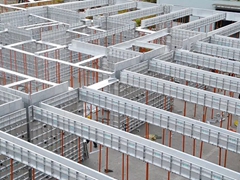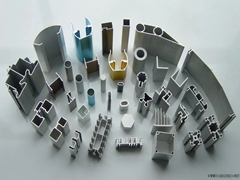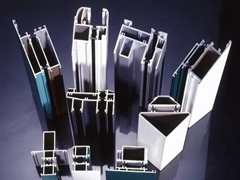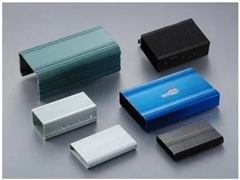Causes and Elimination Methods of Concave-convex Corrugation Defects on the Surface of Aluminum Profiles
Causes of concave and convex corrugation defects on the surface of aluminum profiles:
(1) The ratio of the length of the working belt of the aluminum extrusion die or the design of the cavity size is incorrect, and the flow rate ratio is seriously out of balance.
(2) The work of the aluminum extrusion die has an obstructing angle and a flow-promoting angle.
(3) The drop ratio of the upper and lower working belts of the aluminum extrusion die is too poor.
(4) The working belts of the upper and lower dies of the aluminum extrusion die are not parallel, and there are flared mouths.
(5) The upper die resistance (sub) flow table in the extrusion die cavity of the aluminum profile is too high to block the discharge of the working belt or the drainage groove (size, depth, position) is incorrect.
(6) There are too few or even no empty knives on the outside of the working belt of the aluminum extrusion die (the electric spark is not played well) or too large (the working belt is cracked and deformed without support).
(7) The smoothness of the working belt of the new mold or the repaired aluminum extrusion mold is different due to the unevenness of the rough sand polishing working belt in the mold factory.
(8) There are oil stains on the extrusion working belt of some aluminum profiles.
(9) The support pad is too small to hinder.
(10) Waves appear about 1m from the tail end of the aluminum profile (V3 volume aluminum is pressed in).
Elimination method:
(1) Designing and manufacturing qualified aluminum extrusion dies is the key, and the die factory must eliminate man-made die processing defects.
(2) Serious waves should be dealt with by modifying the mold, changing the mold, and returning it.
(3) There are waves when the new mold or the repaired mold starts to extrude. The first rod can be extruded at low temperature and slow speed, and the re-extrusion can be paused several times in the middle. The purpose is to make the working belt stick to the metal and fill it up. disappear.
(4) Slight waves are handled by increasing the traction force and increasing the amount of stretching.
(5) Slight wave, adjust the deviation of the cylinder and the center of the die surface, so that the amount of aluminum in the cylinder flowing into the die cavity changes to affect the flow rate. This production is feasible when urgently needed. (Not recommended)
(6) The support pad is reasonable and the material is discharged smoothly.
(7) Waves are generated about 1m from the tail end to adjust the thickness and reduce the extrusion speed. Or as a chuck for stretching.
(8) In the process of aluminum production, it is found that the scrap is caused by the small mold empty knife or the flow rate of the aluminum profile. Oil quenching and lubrication can be adjusted on the small side mold working belt and the wipe pad side mold pad. (Pay attention to the inspection of the surface condition of the friction surface)
(1) The ratio of the length of the working belt of the aluminum extrusion die or the design of the cavity size is incorrect, and the flow rate ratio is seriously out of balance.
(2) The work of the aluminum extrusion die has an obstructing angle and a flow-promoting angle.
(3) The drop ratio of the upper and lower working belts of the aluminum extrusion die is too poor.
(4) The working belts of the upper and lower dies of the aluminum extrusion die are not parallel, and there are flared mouths.
(5) The upper die resistance (sub) flow table in the extrusion die cavity of the aluminum profile is too high to block the discharge of the working belt or the drainage groove (size, depth, position) is incorrect.
(6) There are too few or even no empty knives on the outside of the working belt of the aluminum extrusion die (the electric spark is not played well) or too large (the working belt is cracked and deformed without support).
(7) The smoothness of the working belt of the new mold or the repaired aluminum extrusion mold is different due to the unevenness of the rough sand polishing working belt in the mold factory.
(8) There are oil stains on the extrusion working belt of some aluminum profiles.
(9) The support pad is too small to hinder.
(10) Waves appear about 1m from the tail end of the aluminum profile (V3 volume aluminum is pressed in).
Elimination method:
(1) Designing and manufacturing qualified aluminum extrusion dies is the key, and the die factory must eliminate man-made die processing defects.
(2) Serious waves should be dealt with by modifying the mold, changing the mold, and returning it.
(3) There are waves when the new mold or the repaired mold starts to extrude. The first rod can be extruded at low temperature and slow speed, and the re-extrusion can be paused several times in the middle. The purpose is to make the working belt stick to the metal and fill it up. disappear.
(4) Slight waves are handled by increasing the traction force and increasing the amount of stretching.
(5) Slight wave, adjust the deviation of the cylinder and the center of the die surface, so that the amount of aluminum in the cylinder flowing into the die cavity changes to affect the flow rate. This production is feasible when urgently needed. (Not recommended)
(6) The support pad is reasonable and the material is discharged smoothly.
(7) Waves are generated about 1m from the tail end to adjust the thickness and reduce the extrusion speed. Or as a chuck for stretching.
(8) In the process of aluminum production, it is found that the scrap is caused by the small mold empty knife or the flow rate of the aluminum profile. Oil quenching and lubrication can be adjusted on the small side mold working belt and the wipe pad side mold pad. (Pay attention to the inspection of the surface condition of the friction surface)





Leave a comment